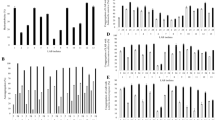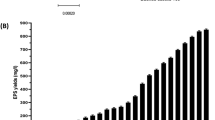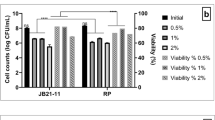Abstract
Probiotic-derived exopolysaccharides are considered as promising sources of carbohydrate with extensive applications in many industries. In the current study, yeast strains were isolated from chicken ingluvies and gizzard samples. According to molecular identification, EPS-producing yeast (Pichia sp. DU2) showed the most similarity to Pichia cactophila (99.67%). Pichia sp. DU2 showed probiotic properties. EPS of Pichia sp. DU2 showed emulsifying activity. The formed emulsions showed 53% (colza oil) and 100% (p-xylene) stability after 24 h. These emulsions were oil-in-water and have stability in the presence of NaCl, KCl, and also acidic and basic conditions. Also, the EPS showed anti-biofilm (29.7–47.6% and 19.06–55.26% against B. cereus and Y. enterocolitica, respectively) and flocculating activities (31.4%). FT-IR showed the presence of various functional groups in EPS structure. Also, its heteropolysaccharide nature was revealed in 1H-NMR and HPLC analysis. This emulsifying EPS showed significant thermal stability and negative zeta potential, which make it a promising carbohydrate for various industries. Finally, according to the predicted model, the maximal EPS production was achieved at reaction time 36 h, pH 6, yeast extract concentration 1.0%, and sucrose concentration 5%. Pichia sp. DU2 with probiotic properties and producing EPS with emulsifying, anti-biofilm, and flocculating activities can be considered as promising yeast strain in various industries like food and pharmaceutical industries.
Graphical Abstract










Similar content being viewed by others
Data availability
Data are available within the article or its supplementary materials.
References
Iyer, A., Mody, K., & Jha, B. (2006). Emulsifying properties of a marine bacterial exopolysaccharide. Enyzme and Microbial Technology, 38(1–2), 220–222.
Karim, A. A., & Bhat, R. (2008). Gelatin alternatives for the food industry: Recent developments, challenges and prospects. Trends in Food Science & Technology, 19(12), 644–656.
Sran, K. S., Sundharam, S. S., Krishnamurthi, S., & Choudhury, A. R. (2019). Production, characterization and bio-emulsifying activity of a novel thermostable exopolysaccharide produced by a marine strain of Rhodobacter johrii CDR-SL 7Cii. International Journal of Biological Macromolecules, 127, 240–249.
Chowdhury, S. R., Basak, R. K., Sen, R., & Adhikari, B. (2011). Characterization and emulsifying property of a carbohydrate polymer produced by Bacillus pumilus UW-02 isolated from waste water irrigated agricultural soil. International Journal of Biological Macromolecules, 48(4), 705–712.
Li, Y., Liu, Y., Cao, C., Zhu, X., Wang, C., Wu, R., & Wu, J. (2020). Extraction and biological activity of exopolysaccharide produced by Leuconostoc mesenteroides SN-8. International Journal of Biological Macromolecules, 157, 36–44.
Gomaa, M., & Yousef, N. (2020). Optimization of production and intrinsic viscosity of an exopolysaccharide from a high yielding Virgibacillus salarius BM02: Study of its potential antioxidant, emulsifying properties and application in the mixotrophic cultivation of Spirulina platensis. International Journal of Biological Macromolecules, 149, 552–561.
Freitas, F., Alves, V. D., Carvalheira, M., Costa, N., Oliveira, R., & Reis, M. A. (2009). Emulsifying behaviour and rheological properties of the extracellular polysaccharide produced by Pseudomonas oleovorans grown on glycerol byproduct. Carbohydrate Polymers, 78(3), 549–556.
McClements, D. J., & Jafari, S. M. (2018). Improving emulsion formation, stability and performance using mixed emulsifiers: A review. Advances in Colloid and Interface Science, 251, 55–79.
Kralova, I., & Sjöblom, J. (2009). Surfactants used in food industry: A review. J Dispers Sci Technol., 30(9), 1363–1383.
Kavitake, D., Balyan, S., Devi, P. B., & Shetty, P. H. (2020). Evaluation of oil-in-water (O/W) emulsifying properties of galactan exopolysaccharide from Weissella confusa KR780676. Journal of Food Science and Technology, 57(4), 1579–1585.
Kumar, A. S., & Mody, K. (2009). Microbial exopolysaccharides: Variety and potential applications. In B. H. M. Rehm (Ed.), Microbial production of biopolymers and polymer precursors: applications and perspectives (pp. 229–253). Caister Academic Press.
Kavita, K., Singh, V. K., Mishra, A., & Jha, B. (2014). Characterisation and anti-biofilm activity of extracellular polymeric substances from Oceanobacillus iheyensis. Carbohydrate Polymers, 101, 29–35.
Sacco, L. P., Castellane, T. C. L., Polachini, T. C., de Macedo Lemos, E. G., & Alves, L. M. C. (2019). Exopolysaccharides produced by Pandoraea shows emulsifying and anti-biofilm activities. Journal of Polymer Research, 26(4), 1–11.
Lahiri, D., Nag, M., Sarkar, T., Dutta, B., & Ray, R. R. (2021). Antibiofilm activity of α-amylase from Bacillus subtilis and prediction of the optimized conditions for biofilm removal by response surface methodology (RSM) and artificial neural network (ANN). Applied Biochemistry and Biotechnology, 193(6), 1853–1872.
Fernández-Pacheco, P., Cueva, C., Arévalo-Villena, M., Moreno-Arribas, M. V., & Pérez, A. B. (2019). Saccharomyces cerevisiae and Hanseniaspora osmophila strains as yeast active cultures for potential probiotic applications. Food & function., 10(8), 4924–4931.
Prasanna, P. H. P., Bell, A., Grandison, A. S., & Charalampopoulos, D. (2012). Emulsifying, rheological and physicochemical properties of exopolysaccharide produced by Bifidobacterium longum subsp. infantis CCUG 52486 and Bifidobacterium infantis NCIMB 702205. Carbohydrate Polymers., 90(1), 533–540.
Merchán, A. V., Benito, M. J., Galván, A. I., & de Herrera, S. R. M. S. (2020). Identification and selection of yeast with functional properties for future application in soft paste cheese. LWT., 124, 109173.
Banik, A., Mondal, J., Rakshit, S., Ghosh, K., Sha, S. P., Halder, S. K., Ghosh, C., & Mondal, K. C. (2019). Amelioration of cold-induced gastric injury by a yeast probiotic isolated from traditional fermented foods. Journal of Functional Foods, 59, 164–173.
Lin, X., Xia, Y., Yang, Y., Wang, G., Zhou, W. and Ai, L. (2020) Probiotic characteristics of Lactobacillus plantarum AR113 and its molecular mechanism of antioxidant. LWT-Food Sci Tech . 126, 109278.
Mallappa, R. H., Singh, D. K., Rokana, N., Pradhan, D., Batish, V. K., & Grover, S. (2019). Screening and selection of probiotic Lactobacillus strains of Indian gut origin based on assessment of desired probiotic attributes combined with principal component and heatmap analysis. LWT., 105, 272–281.
Zhang, G., Zhang, W., Sun, L., Sadiq, F. A., Yang, Y., Gao, J., & Sang, Y. (2019). Preparation screening, production optimization and characterization of exopolysaccharides produced by Lactobacillus sanfranciscensis Ls-1001 isolated from Chinese traditional sourdough. International Journal of Biological Macromolecules, 139, 1295–1303.
Cooper, D. G., & Goldenberg, B. G. (1987). Surface-active agents from two Bacillus species. Applied and Environment Microbiology, 53(2), 224–229.
Yadav, K. L., Rahi, D. K., & Soni, S. K. (2014). Bioemulsifying potential of exopolysaccharide produced by an indigenous species of Aureobasidium pullulans RYLF10. PeerJ PrePrints., 2, e726v1.
Kavitake, D., Balyan, S., Devi, P. B., & Shetty, P. H. (2019). Interface between food grade flavour and water soluble galactan biopolymer to form a stable water-in-oil-in-water emulsion. International Journal of Biological Macromolecules, 135, 445–452.
Davidov-Pardo, G., Gumus, C. E., & McClements, D. J. (2016). (2016) Lutein-enriched emulsion-based delivery systems: Influence of pH and temperature on physical and chemical stability. Food Chemistry, 196, 821–827.
Cui, L., Cho, H. T., McClements, D. J., Decker, E. A., & Park, Y. (2016). Effects of salts on oxidative stability of lipids in Tween-20 stabilized oil-in-water emulsions. Food Chemistry, 197, 1130–1135.
Sarikaya, H., Aslim, B., & Yuksekdag, Z. (2017). Assessment of anti-biofilm activity and bifidogenic growth stimulator (BGS) effect of lyophilized exopolysaccharides (l-EPSs) from Lactobacilli strains. International Journal of Food Properties, 20(2), 362–371.
Lim, D. J., Kim, J. D., Kim, M. Y., Yoo, S. H., & Kong, J. Y. (2007). Physicochemical properties of the exopolysaccharides produced by marine bacterium Zoogloea sp. KCCM10036. Journal of Microbiology and Biotechnology, 17(6), 979–984.
Sarkar, T., Salauddin, M., Mukherjee, A., Shariati, M. A., Rebezov, M., Tretyak, L., Pateiro, M., & Lorenzo, J. M. (2022). Application of bio-inspired optimization algorithms in food processing. Current Research in Food Science, 5, 432–450.
Ragavan, M. L., & Das, N. (2019). Optimization of exopolysaccharide production by probiotic yeast Lipomyces starkeyi VIT-MN03 using response surface methodology and its applications. Annales de Microbiologie, 69(5), 515–530.
Celińska, E., Bonikowski, R., Białas, W., Dobrowolska, A., Słoma, B., Borkowska, M., Kubiak, M., Korpys, P., & Grajek, W. (2018). Pichia cactophila and Kluyveromyces lactis are highly efficient microbial cell factories of natural amino acid-derived aroma compounds. Molecules, 23(1), 97.
Aponte, M., Pepe, O., & Blaiotta, G. (2010). Identification and technological characterization of yeast strains isolated from samples of water buffalo Mozzarella cheese. Journal of Dairy Science, 93(6), 2358–2361.
Wan, H., Liu, T., Su, C., Ji, X., Wang, L., Zhao, Y., & Wang, Z. (2020). Evaluation of bacterial and fungal communities during the fermentation of Baixi sufu, a traditional spicy fermented bean curd. Journal of the Science of Food and Agriculture, 100(4), 1448–1457.
Bourrie, B. C., Willing, B. P., & Cotter, P. D. (2016). The microbiota and health promoting characteristics of the fermented beverage kefir. Frontiers in Microbiology, 7, 647.
Suvarna, S., Dsouza, J., Ragavan, M. L., & Das, N. (2018). Potential probiotic characterization and effect of encapsulation of probiotic yeast strains on survival in simulated gastrointestinal tract condition. Food Science and Biotechnology, 27(3), 745–753.
Zullo, B., & Ciafardini, G. (2019). Evaluation of physiological properties of yeast strains isolated from olive oil and their in vitro probiotic trait. Food Microbiology, 78, 179–187.
Fekri, A., Torbati, M., Khosrowshahi, A. Y., Shamloo, H. B., & Azadmard-Damirchi, S. (2020). Functional effects of phytate-degrading, probiotic lactic acid bacteria and yeast strains isolated from Iranian traditional sourdough on the technological and nutritional properties of whole wheat bread. Food Chemistry, 306, 125620.
Goerges, S., Koslowsky, M., Velagic, S., Borst, N., Bockelmann, W., Heller, K. J., & Scherer, S. (2011). Anti-listerial potential of food-borne yeasts in red smear cheese. International Dairy Journal, 21(2), 83–89.
Binetti, A., Carrasco, M., Reinheimer, J., & Suárez, V. (2013). Yeasts from autochthonal cheese starters: Technological and functional properties. Journal of Applied Microbiology, 115(2), 434–444.
Yildiran, H., Başyiğit Kiliç, G., & Karahan Çakmakçi, A. G. (2019). Characterization and comparison of yeasts from different sources for some probiotic properties and exopolysaccharide production. Food Science and Technology, 39, 646–653.
Kambourova, M., E.T. Oner, and A. Poli. (2015) Exopolysaccharides from prokaryotic microorganisms—promising sources for white biotechnology processes, in Industrial Biorefineries & White Biotechnology., Elsevier. 523–554
Kodali, V. P., Das, S., & Sen, R. (2009). An exopolysaccharide from a probiotic: Biosynthesis dynamics, composition and emulsifying activity. Food Research International, 42(5–6), 695–699.
Humblet-Hua, N.-P.K., van der Linden, E., & Sagis, L. M. (2013). Surface rheological properties of liquid–liquid interfaces stabilized by protein fibrillar aggregates and protein–polysaccharide complexes. Soft Matter, 9(7), 2154–2165.
Dickinson, E. (2009). Hydrocolloids as emulsifiers and emulsion stabilizers. Food Hydrocolloids, 23(6), 1473–1482.
Fabek, H., Messerschmidt, S., Brulport, V., & Goff, H. D. (2014). The effect of in vitro digestive processes on the viscosity of dietary fibres and their influence on glucose diffusion. Food Hydrocoll., 35, 718–726.
Abid, Y., Azabou, S., Blecker, C., Gharsallaoui, A., Corsaro, M. M., Besbes, S., & Attia, H. (2021). Rheological and emulsifying properties of an exopolysaccharide produced by potential probiotic Leuconostoc citreum-BMS strain. Carbohydrate Polymers, 256, 117523.
Han, P. P., Sun, Y., Wu, X. Y., Yuan, Y. J., Dai, Y. J., & Jia, S. R. (2014). Emulsifying, flocculating, and physicochemical properties of exopolysaccharide produced by cyanobacterium Nostoc flagelliforme. Applied Biochemistry and Biotechnology, 172(1), 36–49.
Silambarasan, S., Logeswari, P., Cornejo, P., & Kannan, V. R. (2019). Evaluation of the production of exopolysaccharide by plant growth promoting yeast Rhodotorula sp. strain CAH2 under abiotic stress conditions. International Journal of Biological Macromolecules, 121, 55–62.
Abid, Y., et al. (2018). Production and structural characterization of exopolysaccharides from newly isolated probiotic lactic acid bacteria. International Journal of Biological Macromolecules, 108, 719–728.
Christensen, B. E. (1989). The role of extracellular polysaccharides in biofilms. Journal of Biotechnology, 10(3–4), 181–202.
Imran, M. Y. M., Reehana, N., Jayaraj, K. A., Ahamed, A. A. P., Dhanasekaran, D., Thajuddin, N., Alharbi, N. S., & Muralitharan, G. (2016). Statistical optimization of exopolysaccharide production by Lactobacillus plantarum NTMI05 and NTMI20. International Journal of Biological Macromolecules, 93, 731–745.
Rajoka, M. S. R., Mehwish, H. M., Fang, H., Padhiar, A. A., Zeng, X., Khurshid, M., He, Z., & Zhao, L. (2019). Characterization and anti-tumor activity of exopolysaccharide produced by Lactobacillus kefiri isolated from Chinese kefir grains. Journal of Functional Foods, 63, 103588.
Polak-Berecka, M., Choma, A., Waśko, A., Górska, S., Gamian, A., & Cybulska, J. (2015). Physicochemical characterization of exopolysaccharides produced by Lactobacillus rhamnosus on various carbon sources. Carbohydrate Polymers, 117, 501–509.
Acknowledgements
F. Salimi is thankful to Damghan University for the financial support of current research.
Author information
Authors and Affiliations
Contributions
Fatemeh Salimi and Somaye Imanparast contributed to the study conception and design. Material preparation, data collection, and analysis were performed by Fatemeh Salimi and Somaye Imanparast. All authors commented on previous versions of the manuscript. All authors read and approved the final manuscript.
Corresponding author
Ethics declarations
Ethical Approval
Not applicable.
Consent to Participate
It is warranted that the authors have contributed substantially to the manuscript.
Consent to Publish
It is warranted that the authors have approved the final submission for publication.
Competing Interests
The authors declare no competing interests.
Additional information
Publisher's Note
Springer Nature remains neutral with regard to jurisdictional claims in published maps and institutional affiliations.
Rights and permissions
Springer Nature or its licensor (e.g. a society or other partner) holds exclusive rights to this article under a publishing agreement with the author(s) or other rightsholder(s); author self-archiving of the accepted manuscript version of this article is solely governed by the terms of such publishing agreement and applicable law.
About this article
Cite this article
Salimi, F., Imanparast, S. Characterization of Probiotic Pichia sp. DU2-Derived Exopolysaccharide with Oil-in-Water Emulsifying and Anti-biofilm Activities. Appl Biochem Biotechnol 195, 3345–3365 (2023). https://doi.org/10.1007/s12010-022-04283-y
Accepted:
Published:
Issue Date:
DOI: https://doi.org/10.1007/s12010-022-04283-y




